Procurement and Supply Chain Analysis for Millennium Mill Project
VerifiedAdded on 2023/01/12
|14
|4376
|64
Report
AI Summary
This report provides a comprehensive analysis of procurement methods and supply chain management within the context of the Millennium Mill redevelopment project. It begins by defining procurement and supply chain concepts, emphasizing their importance in construction projects. The report explores various procurement methods, including General Contracting, Design & Build, Management Contracting, Joint Venture, and Private Financing Initiative, ultimately recommending General Contracting as the most suitable approach for the project. Furthermore, the report delves into the structure of the UK economy, particularly concerning procurement and supply chain matters, and examines the economic role of civil engineering within the construction industry. The report highlights the impact of Brexit on procurement, the importance of competitive bidding, and the significance of supply chain management in ensuring efficient construction processes. It also discusses the economic contribution of the construction sector to the UK, including its value added and employment figures. The report concludes by emphasizing the need for effective supply chain management to address potential challenges like capacity constraints and price inflation.
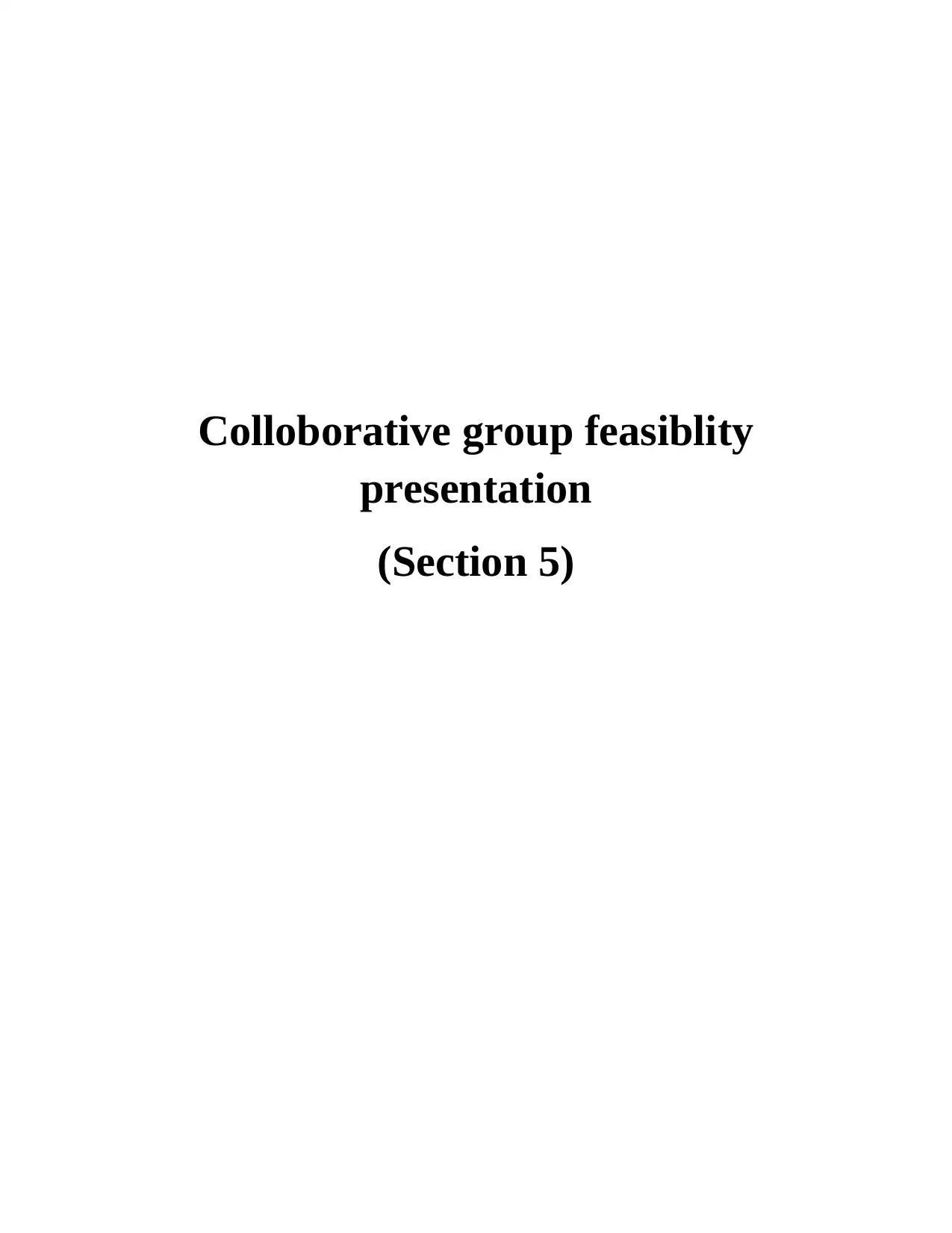
Colloborative group feasiblity
presentation
(Section 5)
presentation
(Section 5)
Paraphrase This Document
Need a fresh take? Get an instant paraphrase of this document with our AI Paraphraser

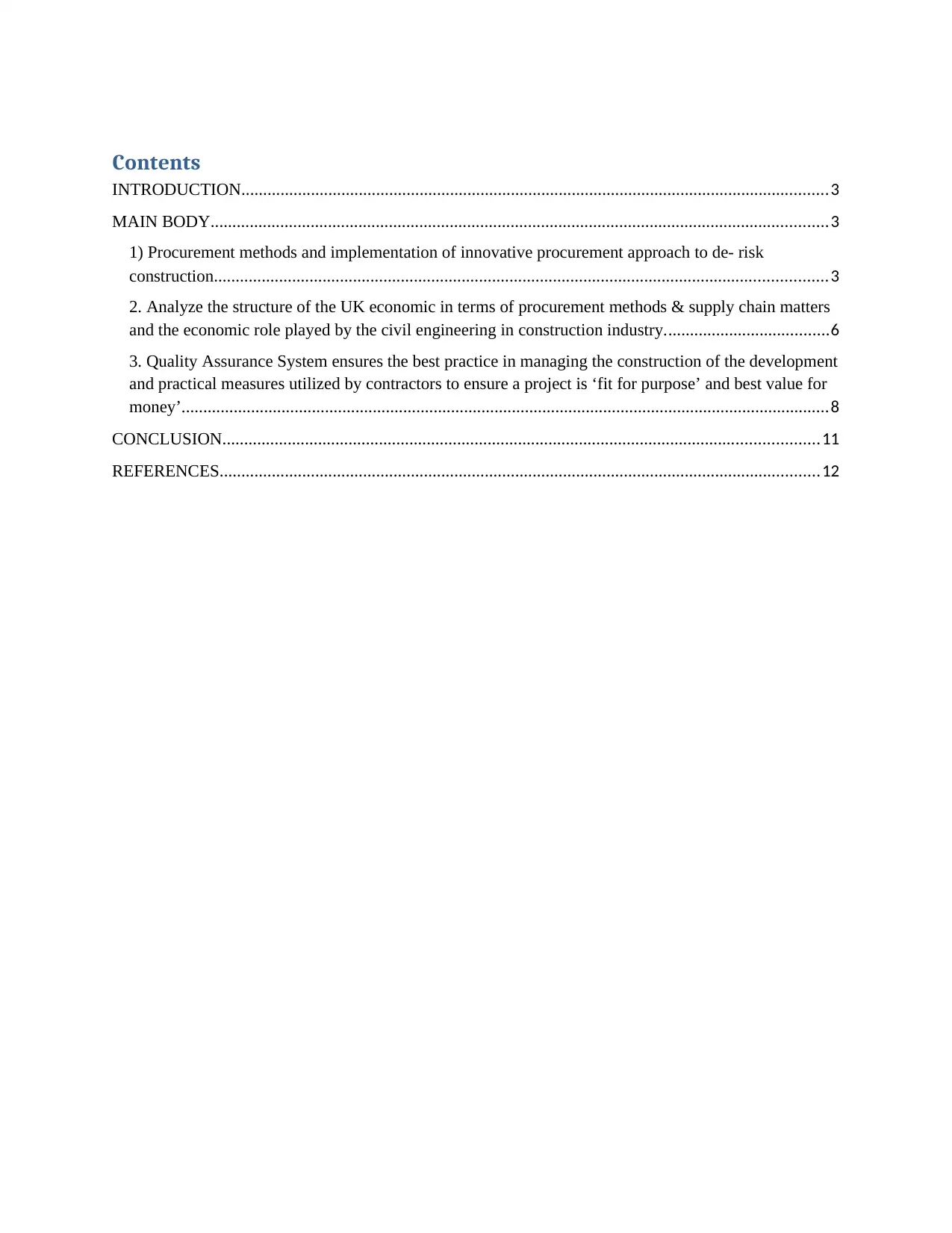
Contents
INTRODUCTION.......................................................................................................................................3
MAIN BODY..............................................................................................................................................3
1) Procurement methods and implementation of innovative procurement approach to de- risk
construction.............................................................................................................................................3
2. Analyze the structure of the UK economic in terms of procurement methods & supply chain matters
and the economic role played by the civil engineering in construction industry......................................6
3. Quality Assurance System ensures the best practice in managing the construction of the development
and practical measures utilized by contractors to ensure a project is ‘fit for purpose’ and best value for
money’.....................................................................................................................................................8
CONCLUSION.........................................................................................................................................11
REFERENCES..........................................................................................................................................12
INTRODUCTION.......................................................................................................................................3
MAIN BODY..............................................................................................................................................3
1) Procurement methods and implementation of innovative procurement approach to de- risk
construction.............................................................................................................................................3
2. Analyze the structure of the UK economic in terms of procurement methods & supply chain matters
and the economic role played by the civil engineering in construction industry......................................6
3. Quality Assurance System ensures the best practice in managing the construction of the development
and practical measures utilized by contractors to ensure a project is ‘fit for purpose’ and best value for
money’.....................................................................................................................................................8
CONCLUSION.........................................................................................................................................11
REFERENCES..........................................................................................................................................12
⊘ This is a preview!⊘
Do you want full access?
Subscribe today to unlock all pages.

Trusted by 1+ million students worldwide
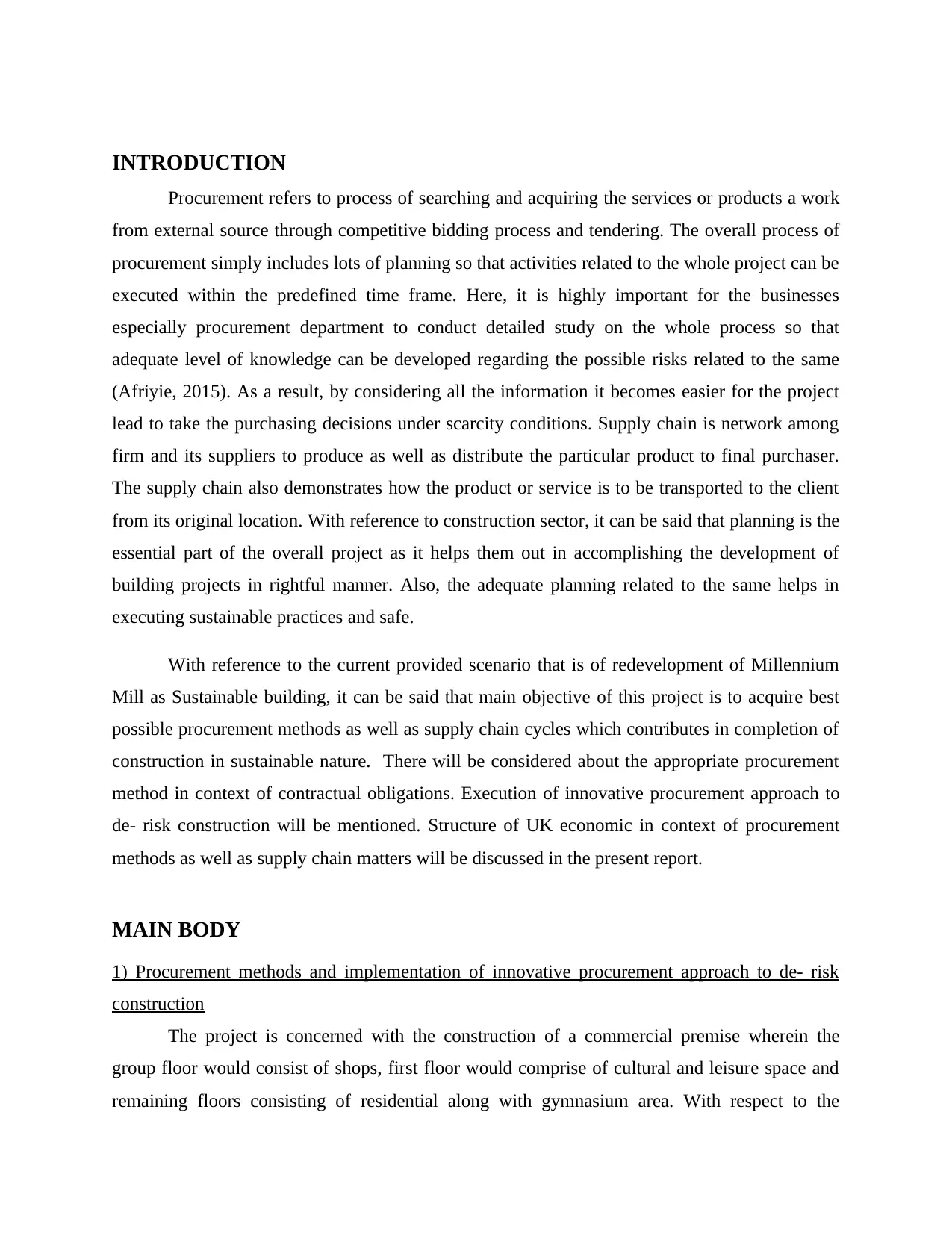
INTRODUCTION
Procurement refers to process of searching and acquiring the services or products a work
from external source through competitive bidding process and tendering. The overall process of
procurement simply includes lots of planning so that activities related to the whole project can be
executed within the predefined time frame. Here, it is highly important for the businesses
especially procurement department to conduct detailed study on the whole process so that
adequate level of knowledge can be developed regarding the possible risks related to the same
(Afriyie, 2015). As a result, by considering all the information it becomes easier for the project
lead to take the purchasing decisions under scarcity conditions. Supply chain is network among
firm and its suppliers to produce as well as distribute the particular product to final purchaser.
The supply chain also demonstrates how the product or service is to be transported to the client
from its original location. With reference to construction sector, it can be said that planning is the
essential part of the overall project as it helps them out in accomplishing the development of
building projects in rightful manner. Also, the adequate planning related to the same helps in
executing sustainable practices and safe.
With reference to the current provided scenario that is of redevelopment of Millennium
Mill as Sustainable building, it can be said that main objective of this project is to acquire best
possible procurement methods as well as supply chain cycles which contributes in completion of
construction in sustainable nature. There will be considered about the appropriate procurement
method in context of contractual obligations. Execution of innovative procurement approach to
de- risk construction will be mentioned. Structure of UK economic in context of procurement
methods as well as supply chain matters will be discussed in the present report.
MAIN BODY
1) Procurement methods and implementation of innovative procurement approach to de- risk
construction
The project is concerned with the construction of a commercial premise wherein the
group floor would consist of shops, first floor would comprise of cultural and leisure space and
remaining floors consisting of residential along with gymnasium area. With respect to the
Procurement refers to process of searching and acquiring the services or products a work
from external source through competitive bidding process and tendering. The overall process of
procurement simply includes lots of planning so that activities related to the whole project can be
executed within the predefined time frame. Here, it is highly important for the businesses
especially procurement department to conduct detailed study on the whole process so that
adequate level of knowledge can be developed regarding the possible risks related to the same
(Afriyie, 2015). As a result, by considering all the information it becomes easier for the project
lead to take the purchasing decisions under scarcity conditions. Supply chain is network among
firm and its suppliers to produce as well as distribute the particular product to final purchaser.
The supply chain also demonstrates how the product or service is to be transported to the client
from its original location. With reference to construction sector, it can be said that planning is the
essential part of the overall project as it helps them out in accomplishing the development of
building projects in rightful manner. Also, the adequate planning related to the same helps in
executing sustainable practices and safe.
With reference to the current provided scenario that is of redevelopment of Millennium
Mill as Sustainable building, it can be said that main objective of this project is to acquire best
possible procurement methods as well as supply chain cycles which contributes in completion of
construction in sustainable nature. There will be considered about the appropriate procurement
method in context of contractual obligations. Execution of innovative procurement approach to
de- risk construction will be mentioned. Structure of UK economic in context of procurement
methods as well as supply chain matters will be discussed in the present report.
MAIN BODY
1) Procurement methods and implementation of innovative procurement approach to de- risk
construction
The project is concerned with the construction of a commercial premise wherein the
group floor would consist of shops, first floor would comprise of cultural and leisure space and
remaining floors consisting of residential along with gymnasium area. With respect to the
Paraphrase This Document
Need a fresh take? Get an instant paraphrase of this document with our AI Paraphraser
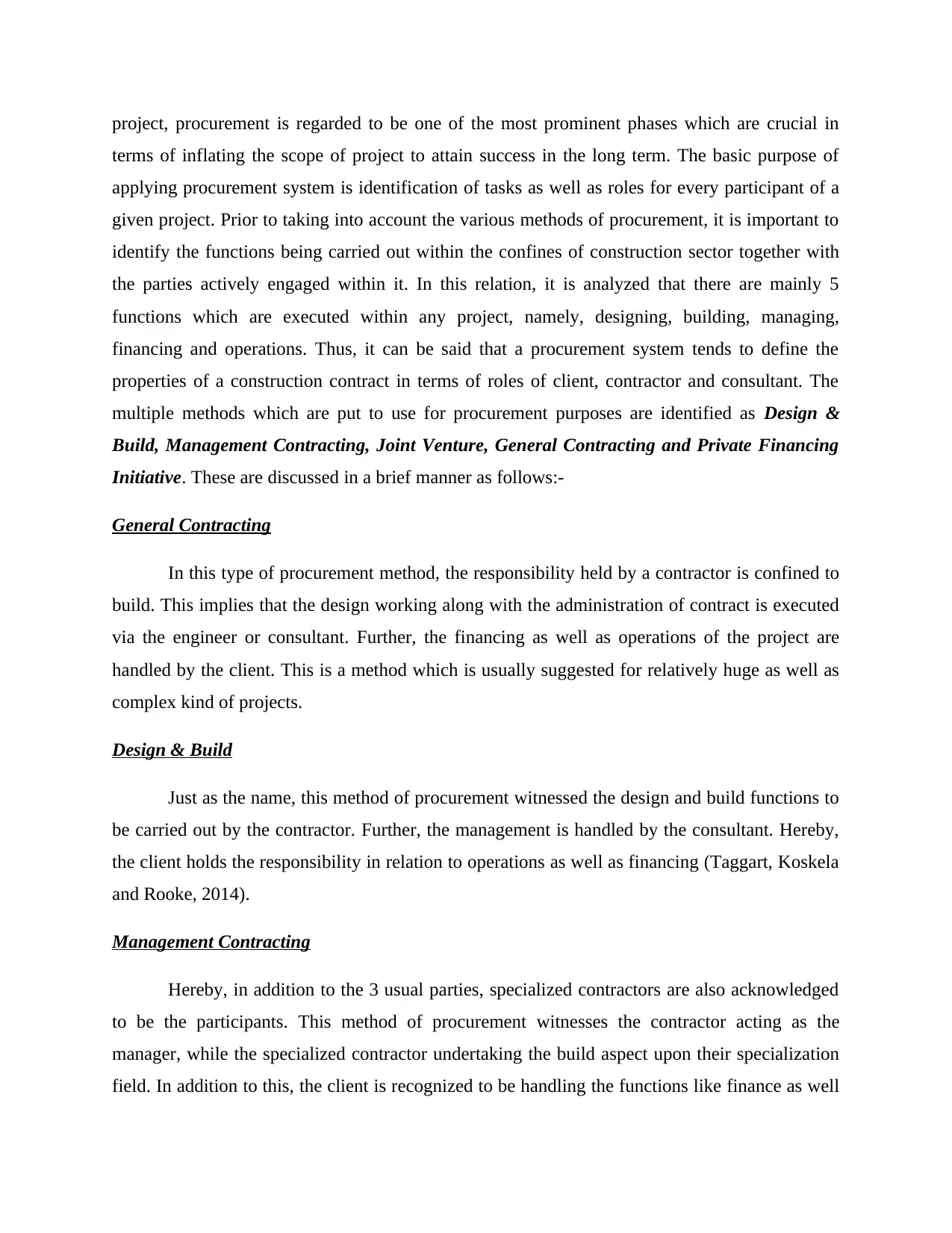
project, procurement is regarded to be one of the most prominent phases which are crucial in
terms of inflating the scope of project to attain success in the long term. The basic purpose of
applying procurement system is identification of tasks as well as roles for every participant of a
given project. Prior to taking into account the various methods of procurement, it is important to
identify the functions being carried out within the confines of construction sector together with
the parties actively engaged within it. In this relation, it is analyzed that there are mainly 5
functions which are executed within any project, namely, designing, building, managing,
financing and operations. Thus, it can be said that a procurement system tends to define the
properties of a construction contract in terms of roles of client, contractor and consultant. The
multiple methods which are put to use for procurement purposes are identified as Design &
Build, Management Contracting, Joint Venture, General Contracting and Private Financing
Initiative. These are discussed in a brief manner as follows:-
General Contracting
In this type of procurement method, the responsibility held by a contractor is confined to
build. This implies that the design working along with the administration of contract is executed
via the engineer or consultant. Further, the financing as well as operations of the project are
handled by the client. This is a method which is usually suggested for relatively huge as well as
complex kind of projects.
Design & Build
Just as the name, this method of procurement witnessed the design and build functions to
be carried out by the contractor. Further, the management is handled by the consultant. Hereby,
the client holds the responsibility in relation to operations as well as financing (Taggart, Koskela
and Rooke, 2014).
Management Contracting
Hereby, in addition to the 3 usual parties, specialized contractors are also acknowledged
to be the participants. This method of procurement witnesses the contractor acting as the
manager, while the specialized contractor undertaking the build aspect upon their specialization
field. In addition to this, the client is recognized to be handling the functions like finance as well
terms of inflating the scope of project to attain success in the long term. The basic purpose of
applying procurement system is identification of tasks as well as roles for every participant of a
given project. Prior to taking into account the various methods of procurement, it is important to
identify the functions being carried out within the confines of construction sector together with
the parties actively engaged within it. In this relation, it is analyzed that there are mainly 5
functions which are executed within any project, namely, designing, building, managing,
financing and operations. Thus, it can be said that a procurement system tends to define the
properties of a construction contract in terms of roles of client, contractor and consultant. The
multiple methods which are put to use for procurement purposes are identified as Design &
Build, Management Contracting, Joint Venture, General Contracting and Private Financing
Initiative. These are discussed in a brief manner as follows:-
General Contracting
In this type of procurement method, the responsibility held by a contractor is confined to
build. This implies that the design working along with the administration of contract is executed
via the engineer or consultant. Further, the financing as well as operations of the project are
handled by the client. This is a method which is usually suggested for relatively huge as well as
complex kind of projects.
Design & Build
Just as the name, this method of procurement witnessed the design and build functions to
be carried out by the contractor. Further, the management is handled by the consultant. Hereby,
the client holds the responsibility in relation to operations as well as financing (Taggart, Koskela
and Rooke, 2014).
Management Contracting
Hereby, in addition to the 3 usual parties, specialized contractors are also acknowledged
to be the participants. This method of procurement witnesses the contractor acting as the
manager, while the specialized contractor undertaking the build aspect upon their specialization
field. In addition to this, the client is recognized to be handling the functions like finance as well
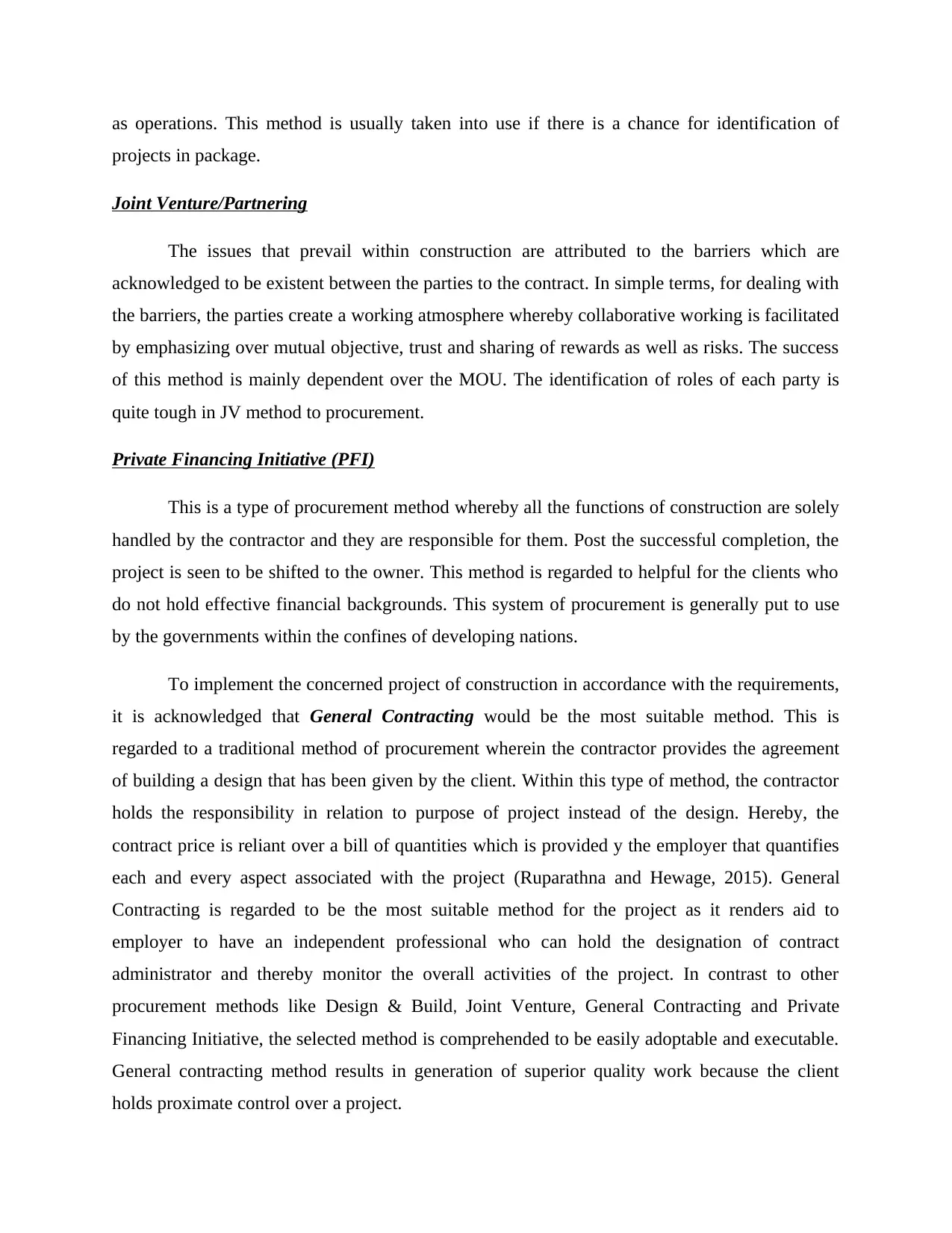
as operations. This method is usually taken into use if there is a chance for identification of
projects in package.
Joint Venture/Partnering
The issues that prevail within construction are attributed to the barriers which are
acknowledged to be existent between the parties to the contract. In simple terms, for dealing with
the barriers, the parties create a working atmosphere whereby collaborative working is facilitated
by emphasizing over mutual objective, trust and sharing of rewards as well as risks. The success
of this method is mainly dependent over the MOU. The identification of roles of each party is
quite tough in JV method to procurement.
Private Financing Initiative (PFI)
This is a type of procurement method whereby all the functions of construction are solely
handled by the contractor and they are responsible for them. Post the successful completion, the
project is seen to be shifted to the owner. This method is regarded to helpful for the clients who
do not hold effective financial backgrounds. This system of procurement is generally put to use
by the governments within the confines of developing nations.
To implement the concerned project of construction in accordance with the requirements,
it is acknowledged that General Contracting would be the most suitable method. This is
regarded to a traditional method of procurement wherein the contractor provides the agreement
of building a design that has been given by the client. Within this type of method, the contractor
holds the responsibility in relation to purpose of project instead of the design. Hereby, the
contract price is reliant over a bill of quantities which is provided y the employer that quantifies
each and every aspect associated with the project (Ruparathna and Hewage, 2015). General
Contracting is regarded to be the most suitable method for the project as it renders aid to
employer to have an independent professional who can hold the designation of contract
administrator and thereby monitor the overall activities of the project. In contrast to other
procurement methods like Design & Build, Joint Venture, General Contracting and Private
Financing Initiative, the selected method is comprehended to be easily adoptable and executable.
General contracting method results in generation of superior quality work because the client
holds proximate control over a project.
projects in package.
Joint Venture/Partnering
The issues that prevail within construction are attributed to the barriers which are
acknowledged to be existent between the parties to the contract. In simple terms, for dealing with
the barriers, the parties create a working atmosphere whereby collaborative working is facilitated
by emphasizing over mutual objective, trust and sharing of rewards as well as risks. The success
of this method is mainly dependent over the MOU. The identification of roles of each party is
quite tough in JV method to procurement.
Private Financing Initiative (PFI)
This is a type of procurement method whereby all the functions of construction are solely
handled by the contractor and they are responsible for them. Post the successful completion, the
project is seen to be shifted to the owner. This method is regarded to helpful for the clients who
do not hold effective financial backgrounds. This system of procurement is generally put to use
by the governments within the confines of developing nations.
To implement the concerned project of construction in accordance with the requirements,
it is acknowledged that General Contracting would be the most suitable method. This is
regarded to a traditional method of procurement wherein the contractor provides the agreement
of building a design that has been given by the client. Within this type of method, the contractor
holds the responsibility in relation to purpose of project instead of the design. Hereby, the
contract price is reliant over a bill of quantities which is provided y the employer that quantifies
each and every aspect associated with the project (Ruparathna and Hewage, 2015). General
Contracting is regarded to be the most suitable method for the project as it renders aid to
employer to have an independent professional who can hold the designation of contract
administrator and thereby monitor the overall activities of the project. In contrast to other
procurement methods like Design & Build, Joint Venture, General Contracting and Private
Financing Initiative, the selected method is comprehended to be easily adoptable and executable.
General contracting method results in generation of superior quality work because the client
holds proximate control over a project.
⊘ This is a preview!⊘
Do you want full access?
Subscribe today to unlock all pages.

Trusted by 1+ million students worldwide
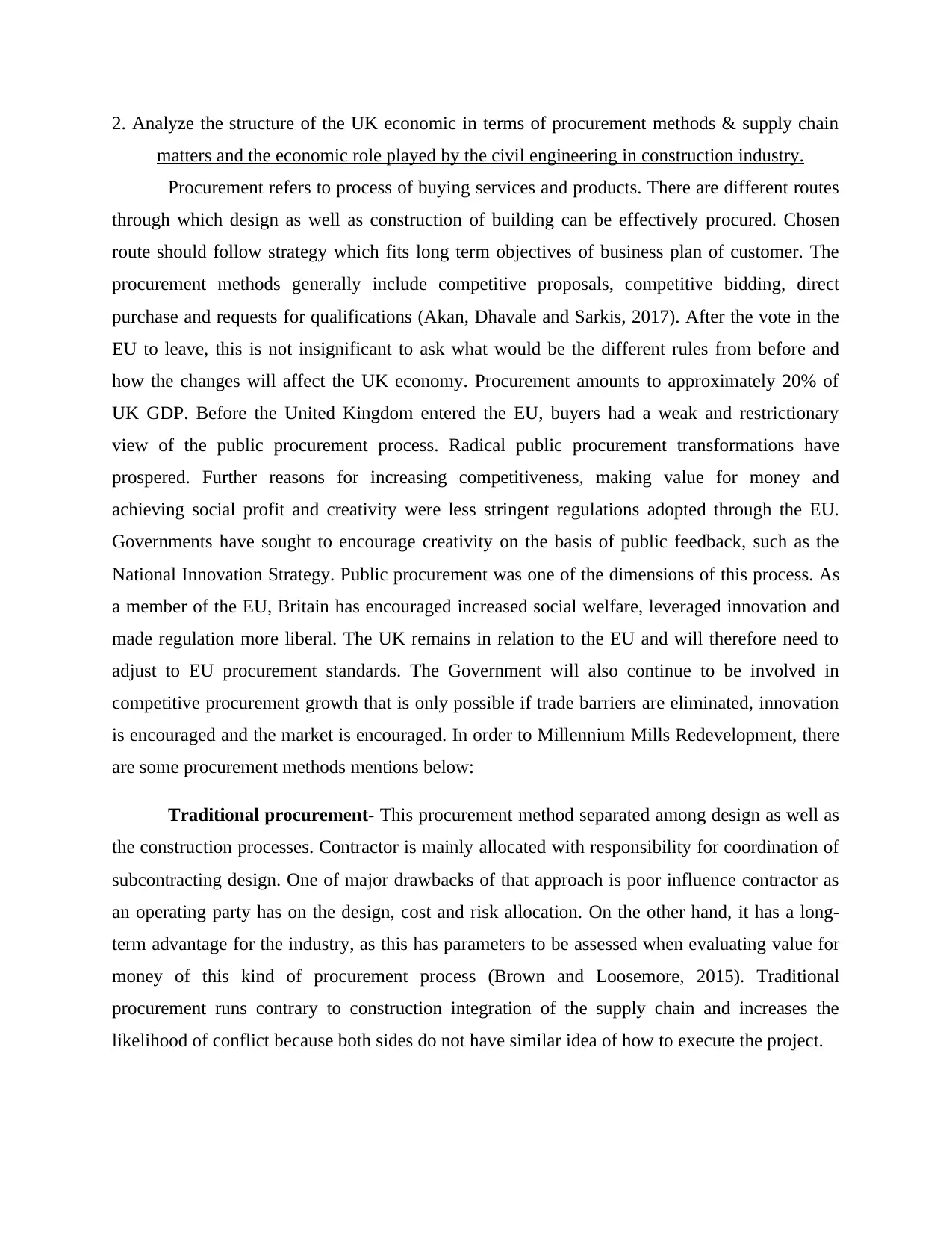
2. Analyze the structure of the UK economic in terms of procurement methods & supply chain
matters and the economic role played by the civil engineering in construction industry.
Procurement refers to process of buying services and products. There are different routes
through which design as well as construction of building can be effectively procured. Chosen
route should follow strategy which fits long term objectives of business plan of customer. The
procurement methods generally include competitive proposals, competitive bidding, direct
purchase and requests for qualifications (Akan, Dhavale and Sarkis, 2017). After the vote in the
EU to leave, this is not insignificant to ask what would be the different rules from before and
how the changes will affect the UK economy. Procurement amounts to approximately 20% of
UK GDP. Before the United Kingdom entered the EU, buyers had a weak and restrictionary
view of the public procurement process. Radical public procurement transformations have
prospered. Further reasons for increasing competitiveness, making value for money and
achieving social profit and creativity were less stringent regulations adopted through the EU.
Governments have sought to encourage creativity on the basis of public feedback, such as the
National Innovation Strategy. Public procurement was one of the dimensions of this process. As
a member of the EU, Britain has encouraged increased social welfare, leveraged innovation and
made regulation more liberal. The UK remains in relation to the EU and will therefore need to
adjust to EU procurement standards. The Government will also continue to be involved in
competitive procurement growth that is only possible if trade barriers are eliminated, innovation
is encouraged and the market is encouraged. In order to Millennium Mills Redevelopment, there
are some procurement methods mentions below:
Traditional procurement- This procurement method separated among design as well as
the construction processes. Contractor is mainly allocated with responsibility for coordination of
subcontracting design. One of major drawbacks of that approach is poor influence contractor as
an operating party has on the design, cost and risk allocation. On the other hand, it has a long-
term advantage for the industry, as this has parameters to be assessed when evaluating value for
money of this kind of procurement process (Brown and Loosemore, 2015). Traditional
procurement runs contrary to construction integration of the supply chain and increases the
likelihood of conflict because both sides do not have similar idea of how to execute the project.
matters and the economic role played by the civil engineering in construction industry.
Procurement refers to process of buying services and products. There are different routes
through which design as well as construction of building can be effectively procured. Chosen
route should follow strategy which fits long term objectives of business plan of customer. The
procurement methods generally include competitive proposals, competitive bidding, direct
purchase and requests for qualifications (Akan, Dhavale and Sarkis, 2017). After the vote in the
EU to leave, this is not insignificant to ask what would be the different rules from before and
how the changes will affect the UK economy. Procurement amounts to approximately 20% of
UK GDP. Before the United Kingdom entered the EU, buyers had a weak and restrictionary
view of the public procurement process. Radical public procurement transformations have
prospered. Further reasons for increasing competitiveness, making value for money and
achieving social profit and creativity were less stringent regulations adopted through the EU.
Governments have sought to encourage creativity on the basis of public feedback, such as the
National Innovation Strategy. Public procurement was one of the dimensions of this process. As
a member of the EU, Britain has encouraged increased social welfare, leveraged innovation and
made regulation more liberal. The UK remains in relation to the EU and will therefore need to
adjust to EU procurement standards. The Government will also continue to be involved in
competitive procurement growth that is only possible if trade barriers are eliminated, innovation
is encouraged and the market is encouraged. In order to Millennium Mills Redevelopment, there
are some procurement methods mentions below:
Traditional procurement- This procurement method separated among design as well as
the construction processes. Contractor is mainly allocated with responsibility for coordination of
subcontracting design. One of major drawbacks of that approach is poor influence contractor as
an operating party has on the design, cost and risk allocation. On the other hand, it has a long-
term advantage for the industry, as this has parameters to be assessed when evaluating value for
money of this kind of procurement process (Brown and Loosemore, 2015). Traditional
procurement runs contrary to construction integration of the supply chain and increases the
likelihood of conflict because both sides do not have similar idea of how to execute the project.
Paraphrase This Document
Need a fresh take? Get an instant paraphrase of this document with our AI Paraphraser
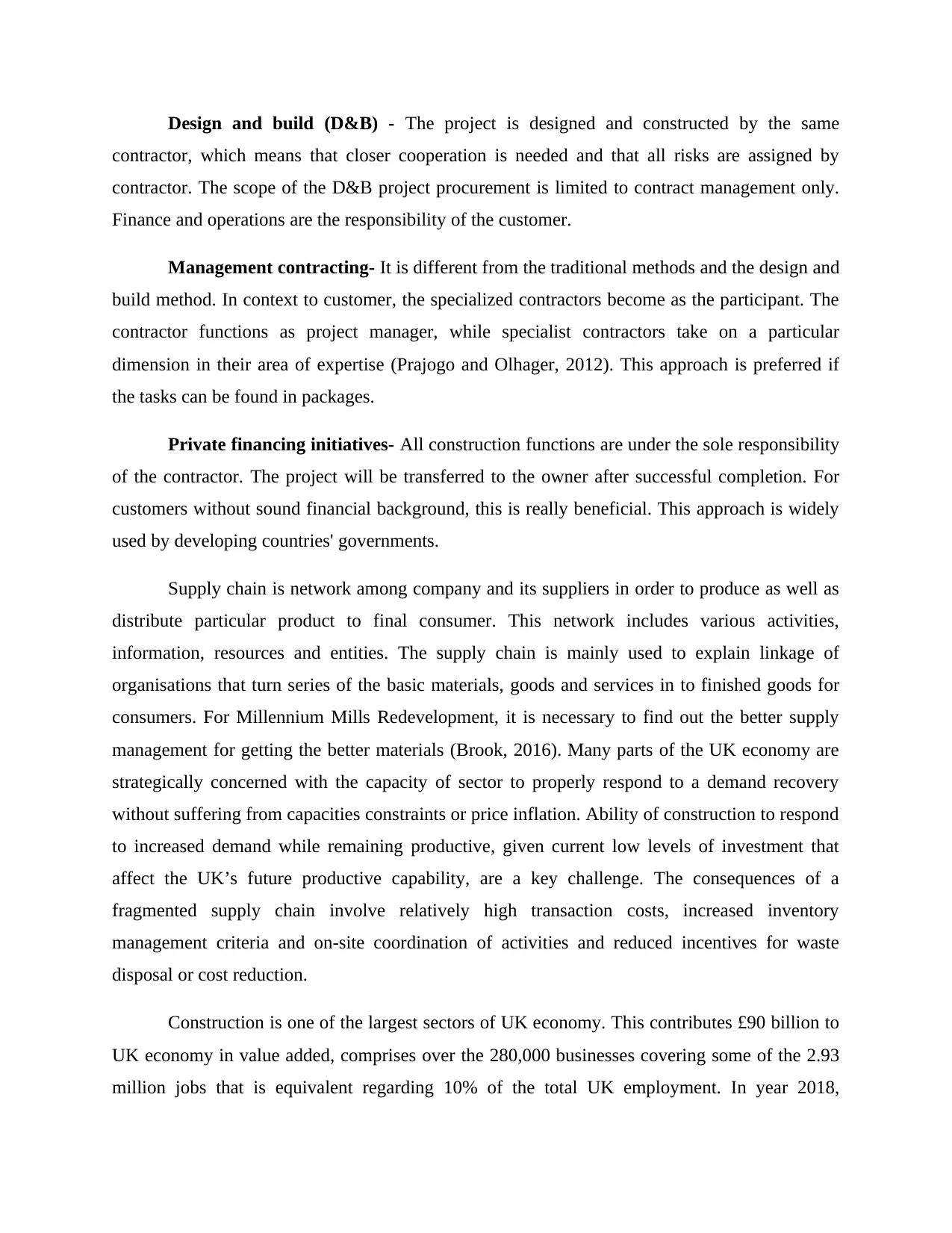
Design and build (D&B) - The project is designed and constructed by the same
contractor, which means that closer cooperation is needed and that all risks are assigned by
contractor. The scope of the D&B project procurement is limited to contract management only.
Finance and operations are the responsibility of the customer.
Management contracting- It is different from the traditional methods and the design and
build method. In context to customer, the specialized contractors become as the participant. The
contractor functions as project manager, while specialist contractors take on a particular
dimension in their area of expertise (Prajogo and Olhager, 2012). This approach is preferred if
the tasks can be found in packages.
Private financing initiatives- All construction functions are under the sole responsibility
of the contractor. The project will be transferred to the owner after successful completion. For
customers without sound financial background, this is really beneficial. This approach is widely
used by developing countries' governments.
Supply chain is network among company and its suppliers in order to produce as well as
distribute particular product to final consumer. This network includes various activities,
information, resources and entities. The supply chain is mainly used to explain linkage of
organisations that turn series of the basic materials, goods and services in to finished goods for
consumers. For Millennium Mills Redevelopment, it is necessary to find out the better supply
management for getting the better materials (Brook, 2016). Many parts of the UK economy are
strategically concerned with the capacity of sector to properly respond to a demand recovery
without suffering from capacities constraints or price inflation. Ability of construction to respond
to increased demand while remaining productive, given current low levels of investment that
affect the UK’s future productive capability, are a key challenge. The consequences of a
fragmented supply chain involve relatively high transaction costs, increased inventory
management criteria and on-site coordination of activities and reduced incentives for waste
disposal or cost reduction.
Construction is one of the largest sectors of UK economy. This contributes £90 billion to
UK economy in value added, comprises over the 280,000 businesses covering some of the 2.93
million jobs that is equivalent regarding 10% of the total UK employment. In year 2018,
contractor, which means that closer cooperation is needed and that all risks are assigned by
contractor. The scope of the D&B project procurement is limited to contract management only.
Finance and operations are the responsibility of the customer.
Management contracting- It is different from the traditional methods and the design and
build method. In context to customer, the specialized contractors become as the participant. The
contractor functions as project manager, while specialist contractors take on a particular
dimension in their area of expertise (Prajogo and Olhager, 2012). This approach is preferred if
the tasks can be found in packages.
Private financing initiatives- All construction functions are under the sole responsibility
of the contractor. The project will be transferred to the owner after successful completion. For
customers without sound financial background, this is really beneficial. This approach is widely
used by developing countries' governments.
Supply chain is network among company and its suppliers in order to produce as well as
distribute particular product to final consumer. This network includes various activities,
information, resources and entities. The supply chain is mainly used to explain linkage of
organisations that turn series of the basic materials, goods and services in to finished goods for
consumers. For Millennium Mills Redevelopment, it is necessary to find out the better supply
management for getting the better materials (Brook, 2016). Many parts of the UK economy are
strategically concerned with the capacity of sector to properly respond to a demand recovery
without suffering from capacities constraints or price inflation. Ability of construction to respond
to increased demand while remaining productive, given current low levels of investment that
affect the UK’s future productive capability, are a key challenge. The consequences of a
fragmented supply chain involve relatively high transaction costs, increased inventory
management criteria and on-site coordination of activities and reduced incentives for waste
disposal or cost reduction.
Construction is one of the largest sectors of UK economy. This contributes £90 billion to
UK economy in value added, comprises over the 280,000 businesses covering some of the 2.93
million jobs that is equivalent regarding 10% of the total UK employment. In year 2018,
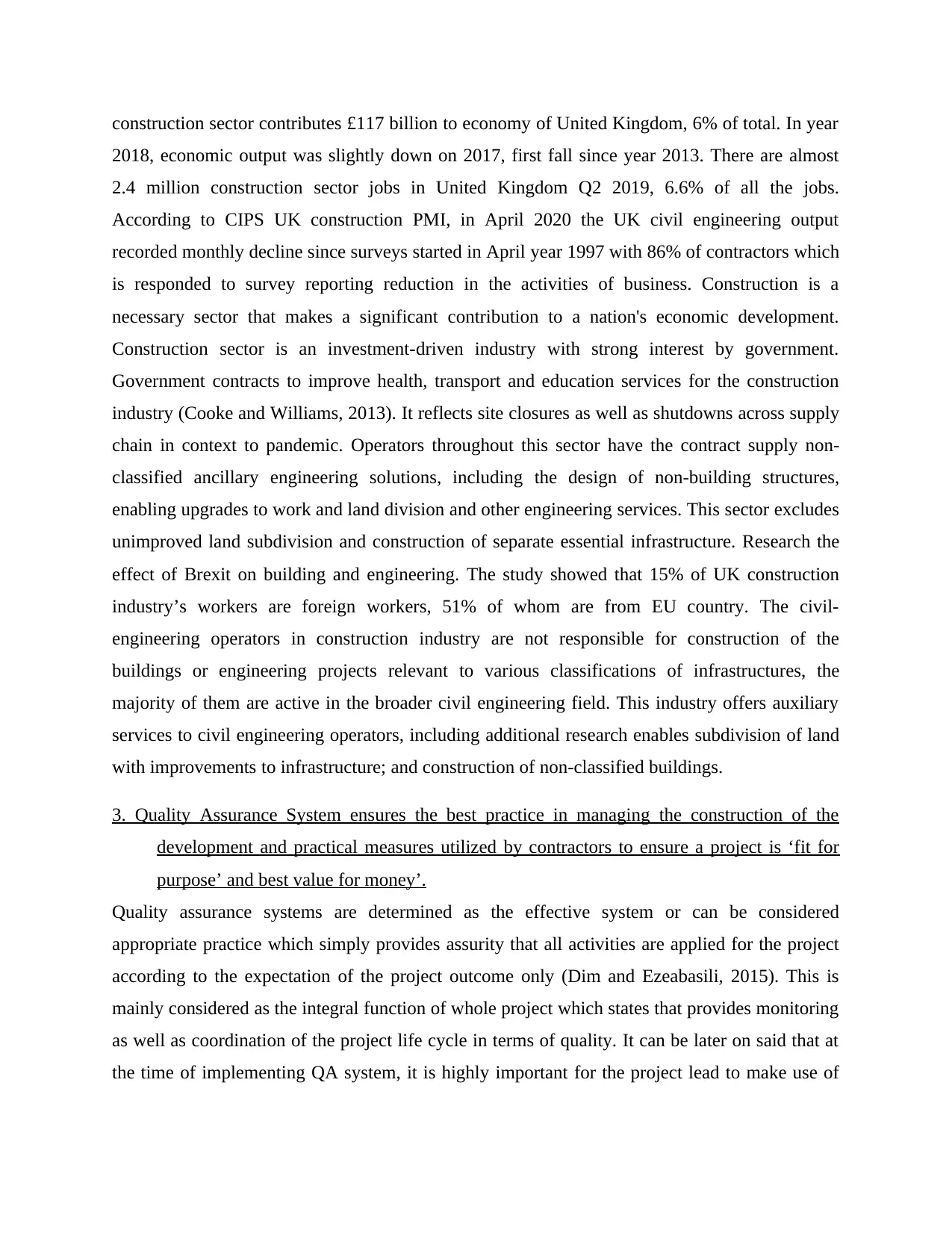
construction sector contributes £117 billion to economy of United Kingdom, 6% of total. In year
2018, economic output was slightly down on 2017, first fall since year 2013. There are almost
2.4 million construction sector jobs in United Kingdom Q2 2019, 6.6% of all the jobs.
According to CIPS UK construction PMI, in April 2020 the UK civil engineering output
recorded monthly decline since surveys started in April year 1997 with 86% of contractors which
is responded to survey reporting reduction in the activities of business. Construction is a
necessary sector that makes a significant contribution to a nation's economic development.
Construction sector is an investment-driven industry with strong interest by government.
Government contracts to improve health, transport and education services for the construction
industry (Cooke and Williams, 2013). It reflects site closures as well as shutdowns across supply
chain in context to pandemic. Operators throughout this sector have the contract supply non-
classified ancillary engineering solutions, including the design of non-building structures,
enabling upgrades to work and land division and other engineering services. This sector excludes
unimproved land subdivision and construction of separate essential infrastructure. Research the
effect of Brexit on building and engineering. The study showed that 15% of UK construction
industry’s workers are foreign workers, 51% of whom are from EU country. The civil-
engineering operators in construction industry are not responsible for construction of the
buildings or engineering projects relevant to various classifications of infrastructures, the
majority of them are active in the broader civil engineering field. This industry offers auxiliary
services to civil engineering operators, including additional research enables subdivision of land
with improvements to infrastructure; and construction of non-classified buildings.
3. Quality Assurance System ensures the best practice in managing the construction of the
development and practical measures utilized by contractors to ensure a project is ‘fit for
purpose’ and best value for money’.
Quality assurance systems are determined as the effective system or can be considered
appropriate practice which simply provides assurity that all activities are applied for the project
according to the expectation of the project outcome only (Dim and Ezeabasili, 2015). This is
mainly considered as the integral function of whole project which states that provides monitoring
as well as coordination of the project life cycle in terms of quality. It can be later on said that at
the time of implementing QA system, it is highly important for the project lead to make use of
2018, economic output was slightly down on 2017, first fall since year 2013. There are almost
2.4 million construction sector jobs in United Kingdom Q2 2019, 6.6% of all the jobs.
According to CIPS UK construction PMI, in April 2020 the UK civil engineering output
recorded monthly decline since surveys started in April year 1997 with 86% of contractors which
is responded to survey reporting reduction in the activities of business. Construction is a
necessary sector that makes a significant contribution to a nation's economic development.
Construction sector is an investment-driven industry with strong interest by government.
Government contracts to improve health, transport and education services for the construction
industry (Cooke and Williams, 2013). It reflects site closures as well as shutdowns across supply
chain in context to pandemic. Operators throughout this sector have the contract supply non-
classified ancillary engineering solutions, including the design of non-building structures,
enabling upgrades to work and land division and other engineering services. This sector excludes
unimproved land subdivision and construction of separate essential infrastructure. Research the
effect of Brexit on building and engineering. The study showed that 15% of UK construction
industry’s workers are foreign workers, 51% of whom are from EU country. The civil-
engineering operators in construction industry are not responsible for construction of the
buildings or engineering projects relevant to various classifications of infrastructures, the
majority of them are active in the broader civil engineering field. This industry offers auxiliary
services to civil engineering operators, including additional research enables subdivision of land
with improvements to infrastructure; and construction of non-classified buildings.
3. Quality Assurance System ensures the best practice in managing the construction of the
development and practical measures utilized by contractors to ensure a project is ‘fit for
purpose’ and best value for money’.
Quality assurance systems are determined as the effective system or can be considered
appropriate practice which simply provides assurity that all activities are applied for the project
according to the expectation of the project outcome only (Dim and Ezeabasili, 2015). This is
mainly considered as the integral function of whole project which states that provides monitoring
as well as coordination of the project life cycle in terms of quality. It can be later on said that at
the time of implementing QA system, it is highly important for the project lead to make use of
⊘ This is a preview!⊘
Do you want full access?
Subscribe today to unlock all pages.

Trusted by 1+ million students worldwide
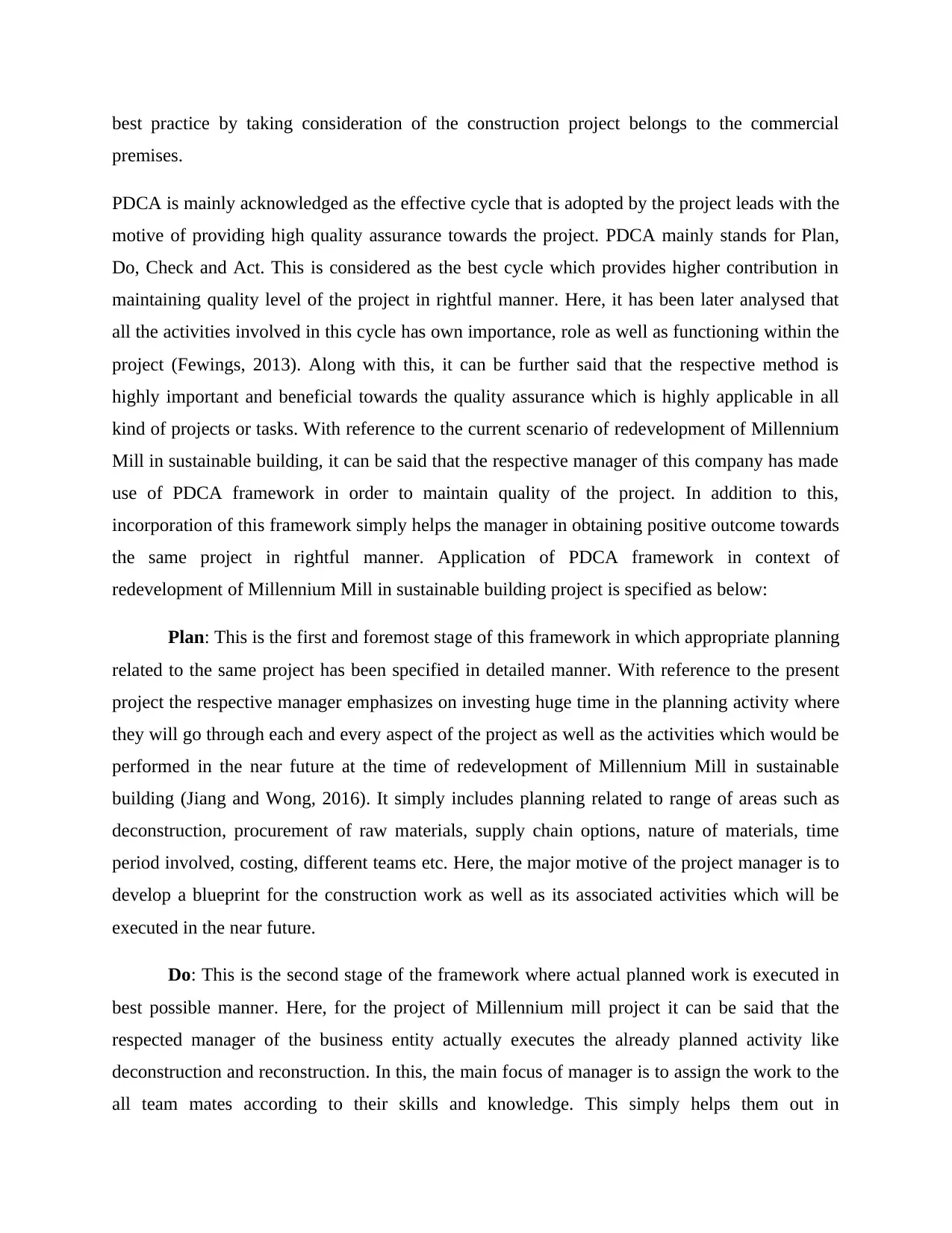
best practice by taking consideration of the construction project belongs to the commercial
premises.
PDCA is mainly acknowledged as the effective cycle that is adopted by the project leads with the
motive of providing high quality assurance towards the project. PDCA mainly stands for Plan,
Do, Check and Act. This is considered as the best cycle which provides higher contribution in
maintaining quality level of the project in rightful manner. Here, it has been later analysed that
all the activities involved in this cycle has own importance, role as well as functioning within the
project (Fewings, 2013). Along with this, it can be further said that the respective method is
highly important and beneficial towards the quality assurance which is highly applicable in all
kind of projects or tasks. With reference to the current scenario of redevelopment of Millennium
Mill in sustainable building, it can be said that the respective manager of this company has made
use of PDCA framework in order to maintain quality of the project. In addition to this,
incorporation of this framework simply helps the manager in obtaining positive outcome towards
the same project in rightful manner. Application of PDCA framework in context of
redevelopment of Millennium Mill in sustainable building project is specified as below:
Plan: This is the first and foremost stage of this framework in which appropriate planning
related to the same project has been specified in detailed manner. With reference to the present
project the respective manager emphasizes on investing huge time in the planning activity where
they will go through each and every aspect of the project as well as the activities which would be
performed in the near future at the time of redevelopment of Millennium Mill in sustainable
building (Jiang and Wong, 2016). It simply includes planning related to range of areas such as
deconstruction, procurement of raw materials, supply chain options, nature of materials, time
period involved, costing, different teams etc. Here, the major motive of the project manager is to
develop a blueprint for the construction work as well as its associated activities which will be
executed in the near future.
Do: This is the second stage of the framework where actual planned work is executed in
best possible manner. Here, for the project of Millennium mill project it can be said that the
respected manager of the business entity actually executes the already planned activity like
deconstruction and reconstruction. In this, the main focus of manager is to assign the work to the
all team mates according to their skills and knowledge. This simply helps them out in
premises.
PDCA is mainly acknowledged as the effective cycle that is adopted by the project leads with the
motive of providing high quality assurance towards the project. PDCA mainly stands for Plan,
Do, Check and Act. This is considered as the best cycle which provides higher contribution in
maintaining quality level of the project in rightful manner. Here, it has been later analysed that
all the activities involved in this cycle has own importance, role as well as functioning within the
project (Fewings, 2013). Along with this, it can be further said that the respective method is
highly important and beneficial towards the quality assurance which is highly applicable in all
kind of projects or tasks. With reference to the current scenario of redevelopment of Millennium
Mill in sustainable building, it can be said that the respective manager of this company has made
use of PDCA framework in order to maintain quality of the project. In addition to this,
incorporation of this framework simply helps the manager in obtaining positive outcome towards
the same project in rightful manner. Application of PDCA framework in context of
redevelopment of Millennium Mill in sustainable building project is specified as below:
Plan: This is the first and foremost stage of this framework in which appropriate planning
related to the same project has been specified in detailed manner. With reference to the present
project the respective manager emphasizes on investing huge time in the planning activity where
they will go through each and every aspect of the project as well as the activities which would be
performed in the near future at the time of redevelopment of Millennium Mill in sustainable
building (Jiang and Wong, 2016). It simply includes planning related to range of areas such as
deconstruction, procurement of raw materials, supply chain options, nature of materials, time
period involved, costing, different teams etc. Here, the major motive of the project manager is to
develop a blueprint for the construction work as well as its associated activities which will be
executed in the near future.
Do: This is the second stage of the framework where actual planned work is executed in
best possible manner. Here, for the project of Millennium mill project it can be said that the
respected manager of the business entity actually executes the already planned activity like
deconstruction and reconstruction. In this, the main focus of manager is to assign the work to the
all team mates according to their skills and knowledge. This simply helps them out in
Paraphrase This Document
Need a fresh take? Get an instant paraphrase of this document with our AI Paraphraser
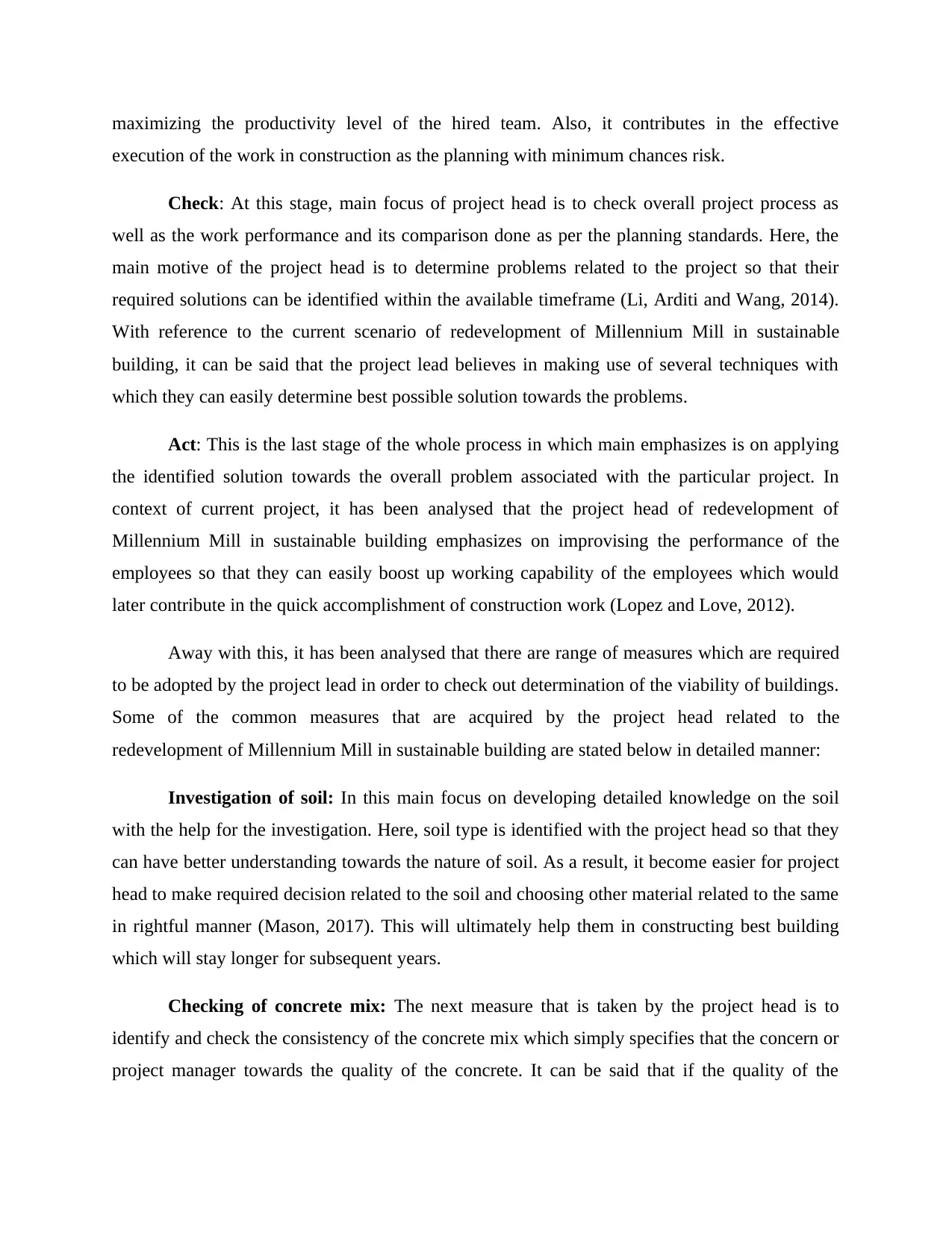
maximizing the productivity level of the hired team. Also, it contributes in the effective
execution of the work in construction as the planning with minimum chances risk.
Check: At this stage, main focus of project head is to check overall project process as
well as the work performance and its comparison done as per the planning standards. Here, the
main motive of the project head is to determine problems related to the project so that their
required solutions can be identified within the available timeframe (Li, Arditi and Wang, 2014).
With reference to the current scenario of redevelopment of Millennium Mill in sustainable
building, it can be said that the project lead believes in making use of several techniques with
which they can easily determine best possible solution towards the problems.
Act: This is the last stage of the whole process in which main emphasizes is on applying
the identified solution towards the overall problem associated with the particular project. In
context of current project, it has been analysed that the project head of redevelopment of
Millennium Mill in sustainable building emphasizes on improvising the performance of the
employees so that they can easily boost up working capability of the employees which would
later contribute in the quick accomplishment of construction work (Lopez and Love, 2012).
Away with this, it has been analysed that there are range of measures which are required
to be adopted by the project lead in order to check out determination of the viability of buildings.
Some of the common measures that are acquired by the project head related to the
redevelopment of Millennium Mill in sustainable building are stated below in detailed manner:
Investigation of soil: In this main focus on developing detailed knowledge on the soil
with the help for the investigation. Here, soil type is identified with the project head so that they
can have better understanding towards the nature of soil. As a result, it become easier for project
head to make required decision related to the soil and choosing other material related to the same
in rightful manner (Mason, 2017). This will ultimately help them in constructing best building
which will stay longer for subsequent years.
Checking of concrete mix: The next measure that is taken by the project head is to
identify and check the consistency of the concrete mix which simply specifies that the concern or
project manager towards the quality of the concrete. It can be said that if the quality of the
execution of the work in construction as the planning with minimum chances risk.
Check: At this stage, main focus of project head is to check overall project process as
well as the work performance and its comparison done as per the planning standards. Here, the
main motive of the project head is to determine problems related to the project so that their
required solutions can be identified within the available timeframe (Li, Arditi and Wang, 2014).
With reference to the current scenario of redevelopment of Millennium Mill in sustainable
building, it can be said that the project lead believes in making use of several techniques with
which they can easily determine best possible solution towards the problems.
Act: This is the last stage of the whole process in which main emphasizes is on applying
the identified solution towards the overall problem associated with the particular project. In
context of current project, it has been analysed that the project head of redevelopment of
Millennium Mill in sustainable building emphasizes on improvising the performance of the
employees so that they can easily boost up working capability of the employees which would
later contribute in the quick accomplishment of construction work (Lopez and Love, 2012).
Away with this, it has been analysed that there are range of measures which are required
to be adopted by the project lead in order to check out determination of the viability of buildings.
Some of the common measures that are acquired by the project head related to the
redevelopment of Millennium Mill in sustainable building are stated below in detailed manner:
Investigation of soil: In this main focus on developing detailed knowledge on the soil
with the help for the investigation. Here, soil type is identified with the project head so that they
can have better understanding towards the nature of soil. As a result, it become easier for project
head to make required decision related to the soil and choosing other material related to the same
in rightful manner (Mason, 2017). This will ultimately help them in constructing best building
which will stay longer for subsequent years.
Checking of concrete mix: The next measure that is taken by the project head is to
identify and check the consistency of the concrete mix which simply specifies that the concern or
project manager towards the quality of the concrete. It can be said that if the quality of the
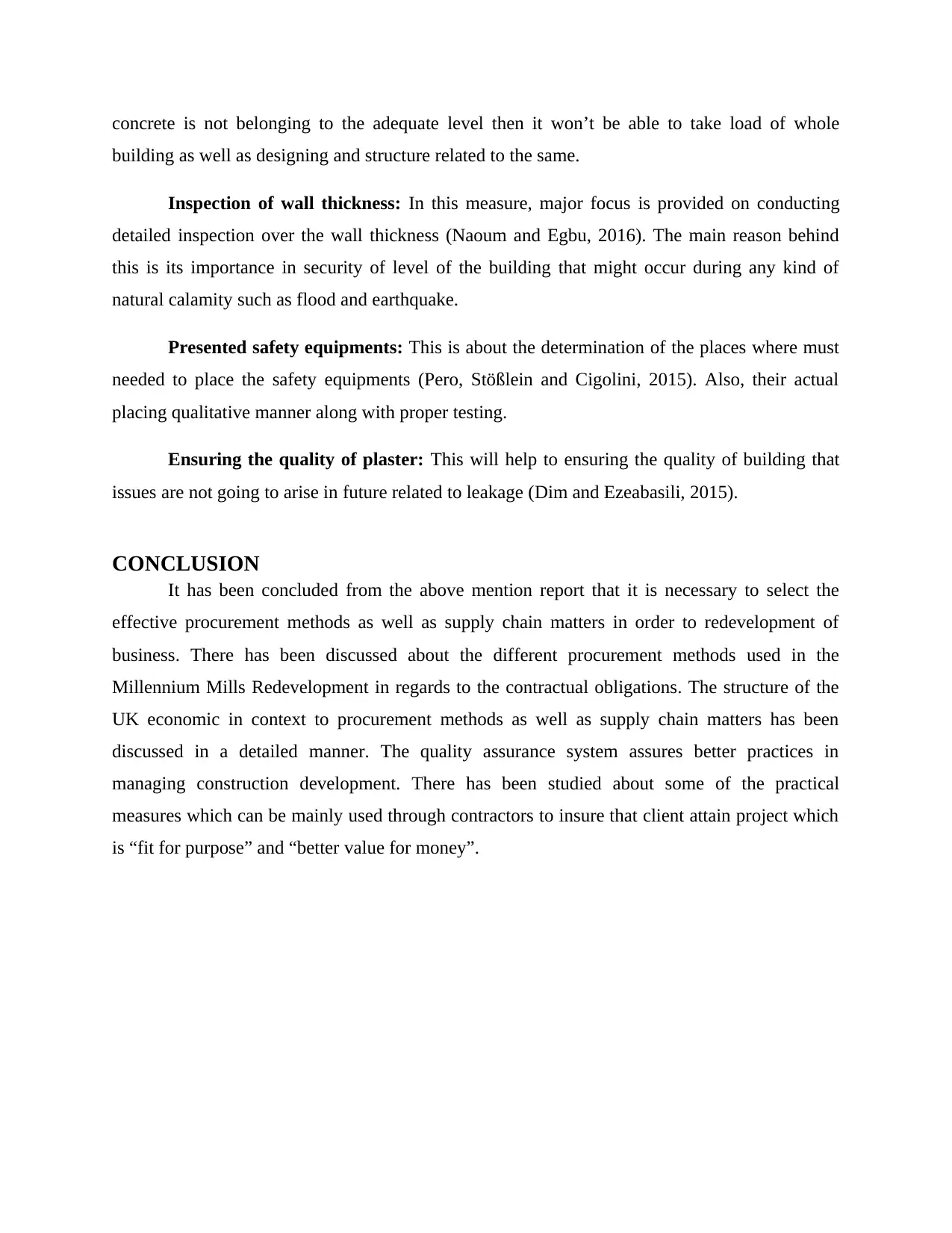
concrete is not belonging to the adequate level then it won’t be able to take load of whole
building as well as designing and structure related to the same.
Inspection of wall thickness: In this measure, major focus is provided on conducting
detailed inspection over the wall thickness (Naoum and Egbu, 2016). The main reason behind
this is its importance in security of level of the building that might occur during any kind of
natural calamity such as flood and earthquake.
Presented safety equipments: This is about the determination of the places where must
needed to place the safety equipments (Pero, Stößlein and Cigolini, 2015). Also, their actual
placing qualitative manner along with proper testing.
Ensuring the quality of plaster: This will help to ensuring the quality of building that
issues are not going to arise in future related to leakage (Dim and Ezeabasili, 2015).
CONCLUSION
It has been concluded from the above mention report that it is necessary to select the
effective procurement methods as well as supply chain matters in order to redevelopment of
business. There has been discussed about the different procurement methods used in the
Millennium Mills Redevelopment in regards to the contractual obligations. The structure of the
UK economic in context to procurement methods as well as supply chain matters has been
discussed in a detailed manner. The quality assurance system assures better practices in
managing construction development. There has been studied about some of the practical
measures which can be mainly used through contractors to insure that client attain project which
is “fit for purpose” and “better value for money”.
building as well as designing and structure related to the same.
Inspection of wall thickness: In this measure, major focus is provided on conducting
detailed inspection over the wall thickness (Naoum and Egbu, 2016). The main reason behind
this is its importance in security of level of the building that might occur during any kind of
natural calamity such as flood and earthquake.
Presented safety equipments: This is about the determination of the places where must
needed to place the safety equipments (Pero, Stößlein and Cigolini, 2015). Also, their actual
placing qualitative manner along with proper testing.
Ensuring the quality of plaster: This will help to ensuring the quality of building that
issues are not going to arise in future related to leakage (Dim and Ezeabasili, 2015).
CONCLUSION
It has been concluded from the above mention report that it is necessary to select the
effective procurement methods as well as supply chain matters in order to redevelopment of
business. There has been discussed about the different procurement methods used in the
Millennium Mills Redevelopment in regards to the contractual obligations. The structure of the
UK economic in context to procurement methods as well as supply chain matters has been
discussed in a detailed manner. The quality assurance system assures better practices in
managing construction development. There has been studied about some of the practical
measures which can be mainly used through contractors to insure that client attain project which
is “fit for purpose” and “better value for money”.
⊘ This is a preview!⊘
Do you want full access?
Subscribe today to unlock all pages.

Trusted by 1+ million students worldwide
1 out of 14
Related Documents
Your All-in-One AI-Powered Toolkit for Academic Success.
+13062052269
info@desklib.com
Available 24*7 on WhatsApp / Email
![[object Object]](/_next/static/media/star-bottom.7253800d.svg)
Unlock your academic potential
Copyright © 2020–2025 A2Z Services. All Rights Reserved. Developed and managed by ZUCOL.





